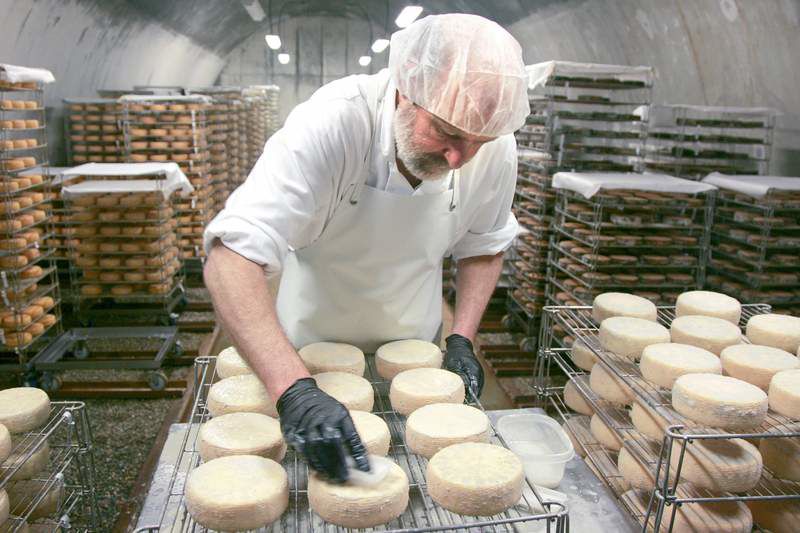Cheesemakers fret over possible new rules
Published 4:00 am Saturday, February 5, 2011

- Bill Desrochers washes rounds of Von Trapp Homestead Oma cheese at Jasper Hill Farm in Greensboro, Vt., on Tuesday. As federal regulators consider whether to tighten food safety rules for cheese made with unpasteurized milk, artisanal producers fear their businesses will suffer.
Federal regulators are considering whether to tighten food safety rules for cheese made with unpasteurized milk — and the possibility has cheesemakers and foodies worried that the result will be cheese that is less tasty and not much safer.
The new proposals, which are expected in the next several months, come after a very tough year for this country’s fast-growing gourmet cheese industry, marked by recalls and two multistate E. coli outbreaks that sickened nearly 50 people.
Trending
Unpasteurized milk, often called raw milk, is prized by many cheesemakers, who say that it adds a special richness of flavor.
The debate focuses on a federal rule that requires cheese made from raw milk to be aged for 60 days before it is deemed safe to eat. Raw milk has not been heated to kill harmful bacteria, a process known as pasteurization. So aging allows the chemicals in cheese, including acids and salt, time to destroy harmful bacteria.
Scientists have found, however, that 60 days of aging is an overly simplistic guideline, in part because there are so many types of cheese and different ones may require different safeguards.
The Food and Drug Administration began a comprehensive review of the 60-day aging rule in 2009. Officials said the review was done and was awaiting approval before release.
The FDA has not tipped its hand, but some in the industry fear that raw milk cheese could be banned or that some types of cheese deemed to pose a higher safety risk could no longer be made with raw milk. Others say they believe the aging period may be extended, perhaps to 90 days. That could make it difficult or impossible for cheesemakers to continue using raw milk for some popular cheese styles, like blue cheese or taleggio-type cheeses, that may not lend themselves to such lengthy aging.
“A very important and thriving section of the American agricultural scene is in danger of being compromised or put out of business if the 60-day minimum were to be raised or if raw milk cheeses were to be entirely outlawed,” said Liz Thorpe, a vice president of Murray’s Cheese, a Manhattan retailer where about half the cheese is made with raw milk.
Trending
Mateo Kehler, a co-owner of Jasper Hill Farm in Greensboro, Vt., makes cheese from both raw and pasteurized milk but he considers raw milk an essential ingredient for some of his most popular cheeses. “We’re afraid that we’re going to lose the opportunity to produce some of the products that we make even though we’re doing it in the most responsible possible way,” Kehler said.
Cheesemakers say pasteurizing milk destroys enzymes and good bacteria that add flavor to cheese. Raw milk cheese, they say, has flavors that derive from the animals and the pastureland that produced the milk, much as wine is said to draw unique flavors from individual vineyards.
Cheese made with pasteurized milk can also present food safety hazards if it becomes contaminated after the pasteurization step — during production or aging, for example. Last year, at least nine domestic cheesemakers issued major recalls. Five used pasteurized milk and four used raw milk.
But two of the raw milk cheese recalls came after the cheese was linked to outbreaks of a highly toxic form of E. coli bacteria.
In one outbreak, 38 people in five states became sick from raw milk Gouda made by Bravo Farms of Traver, Calif., and sold through Costco, the giant retailer. In another outbreak, eight people in four states were sickened by bacteria traced to soft cheeses made by Sally Jackson, a pioneering cheesemaker in Oroville, Wash.
Investigators have not said whether the contamination in those cases has been traced to the unpasteurized milk used to make the cheese.
All the fuss is over a rule that some experts say is a blatant anachronism.
The aging rule was created in the late 1940s in response to outbreaks of typhoid fever linked to cheese.
Scientists knew then that hard cheeses, like cheddar, dried out as they aged, making them less hospitable to bacteria.
So regulators decided that if cheese was not made with pasteurized milk, it should be aged. But the choice of 60 days as the necessary threshold was a fairly arbitrary one, according to Dennis D’Amico, senior research scientist of the Vermont Institute for Artisan Cheese of the University of Vermont.
Since then, many things have changed. The primary pathogens that now cause illness associated with cheese, like toxic forms of E. coli and listeria, were either unknown in the 1940s or not of great concern. And artisan cheesemakers today are making many cheeses whose chemistry varies greatly from the basic hard cheddar of six decades ago.
“The 60-day rule wasn’t based on real science,” D’Amico said. “The pathogens have changed and the cheeses have certainly changed. But the rule has not.”
D’Amico and Catherine Donnelly, co-director of the Vermont institute, published a paper late last year showing that toxic E. coli could survive in cheese for more than a year. Another study, which they published in 2008, showed that listeria levels increased in soft cheeses, like brie, as they aged, making them potentially more dangerous. Those cheeses have a higher moisture content and become less acidic as they age, conditions that can favor bacterial growth.
D’Amico said aging could be effective as a safeguard in hard cheeses if it were combined with careful control of milk quality, improved sanitation and testing in cheese plants.







